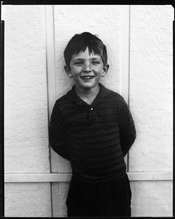Sharktooth
Member
There's a good description of this left knob from a posting years ago on Photrio. Sinar Calculator
It's an interesting concept, and could be used on any camera quite easily. I have to give credit to Sinar for some ingenuity here. Just draw any two horizontal lines on the ground glass, one below the center axis, and the other above. Focus on the one of these lines and note the focus scale position. Next, focus on the other line, and note the focus scale position of that one. The difference between the two positions is the focus travel between the two points (fore/aft). The up/down dimension is the distance between the two lines. The fore/aft and up/down dimensions form the legs of a right angled triangle, and the angle of the resulting hypotenuse is the tilt angle. It's just a simple math calculation.
Since the upper and lower lines on the Sinar ground glass are already fixed and known, the only variable is the fore/aft focus difference. The left side knob rotates with the fore/aft focus, so it's marked with the corresponding tilt required. Very smart and cheap. This is something you could jury rig on just about any camera.
I have a Sinar f, and it doesn't have this left knob, so I wasn't sure if the f2 was somehow different. All the Sinar f models have standard base tilts, so they're no different from the Sinar Norma in that respect. The Sinar P series is a completely different animal. You don't need a calculator to figure out the tilt angle since it's asymmetric within the film area.
It's an interesting concept, and could be used on any camera quite easily. I have to give credit to Sinar for some ingenuity here. Just draw any two horizontal lines on the ground glass, one below the center axis, and the other above. Focus on the one of these lines and note the focus scale position. Next, focus on the other line, and note the focus scale position of that one. The difference between the two positions is the focus travel between the two points (fore/aft). The up/down dimension is the distance between the two lines. The fore/aft and up/down dimensions form the legs of a right angled triangle, and the angle of the resulting hypotenuse is the tilt angle. It's just a simple math calculation.
Since the upper and lower lines on the Sinar ground glass are already fixed and known, the only variable is the fore/aft focus difference. The left side knob rotates with the fore/aft focus, so it's marked with the corresponding tilt required. Very smart and cheap. This is something you could jury rig on just about any camera.
I have a Sinar f, and it doesn't have this left knob, so I wasn't sure if the f2 was somehow different. All the Sinar f models have standard base tilts, so they're no different from the Sinar Norma in that respect. The Sinar P series is a completely different animal. You don't need a calculator to figure out the tilt angle since it's asymmetric within the film area.
Last edited:







